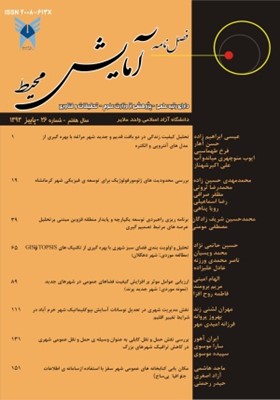ارزیابی عوامل موثر بر افزایش کیفیت فضاهای عمومی در شهرهای جدید نمونه موردی: شهر جدید پرند
محورهای موضوعی : آمایش محیطالهام امینی 1 , مریم برومند 2 * , فاطمه روح افزا 3
1 - (دکترای شهرسازی، عضو هیات علمی دانشگاه آزاد اسلامی، واحد پردیس، گروه شهرسازی، تهران، ایران)
2 - (دانشجوی دکترای شهرسازی، دانشگاه آزاد اسلامی, واحد نجفآباد، گروه شهرسازی، اصفهان، ایران)
3 - (کارشناس ارشد شهرسازی)
کلید واژه: کیفیت محیط, تعاملات اجتماعی, فضاهای شهری, شهرهای جدید,
چکیده مقاله :
در قرن اخیر برای نخستین بار در تاریخ بشر، تعداد شهرنشینان از تعداد روستانشینان فراتر رفته است. افزایش جمعیت شهری، برنامه ریزان را ناگزیر به توسعه ی شهرها و احداث شهرهای جدید جهت اسکان سرریز جمعیت کلان شهرها نموده است. پیامدهای حاصل از این رشد شتابان از یک سو و تحقیقات صورت گرفته که نشان از عدم رضایتمندی شهروندان از عوارض و سیاست های توسعه ی شهری دارند از سوی دیگر، چاره جویی برای رفع مشکلات ناشی از توسعه ی شهرها و احداث شهرهای جدید را به یکی از دغدغه های برنامه ریزان و مدیران شهری در سطح جهان تبدیل نموده است. در این میان فضاهای عمومی شهری به عنوان فضاهایی قابل دسترس برای همه و بستری برای کنش های اجتماعی، از اهمیت زیادی برخوردارند. بررسی شهرهای جدید در ایران حاکی از عدم موفقیت در ایجاد فضاهایی با کیفیت مطلوب است. این گونه شهرها که تنها در پی پاسخ به نیاز سکونت سرریز جمعیت کلان شهرها شکل گرفته اند، از فضاهای عمومی با کیفیت شهری که تاثیرات قابل توجهی در سلامت روحی و جسمی شهروندان دارند، بی بهره اند. مقاله حاضر با مروری بر مفهوم کیفیت محیط و مولفه های موثر بر آن، تلاشی است برای پاسخگویی به این سوال که چه عواملی بر افزایش کیفیت فضاهای عمومی در شهرهای جدید موثرند؟ با توجه به ماهیت داده ها، از روش تحقیق توصیفی و همبستگی استفاده شده است. نتایج حاصل از مطالعه شهر جدید پرند در ایران، حاکی از آن است که میان برقراری تعاملات اجتماعی، میزان دسترسی پذیری به فضا و خصوصیات شخصی شهروندان و افزایش کیفیت فضاهای عمومی شهری در شهرهای جدید رابطه معناداری وجود دارد.
In recent century, the urban population exceeded the rural population for the first time in the history. The increase of the urban population has forced the planners and policy-makers to develop the cities and establish new cities for the settlement of population overflow of the metropolises. The consequences of such a rapid growth on the one hand, and the results of the researches that show the dissatisfaction of the citizens with the policies of the urban development on the other hand, have made the urban managers and policy-makers look for the solution of the problems that are imposed by the development of the cities and establishing new cities worldwide. Meanwhile, the urban public spaces are critically important because they are accessed by all citizens and are regarded as the context of the social actions. An overview on the Iranian new cities shows the failure of the authorities in creating qualitatively desirable spaces. Indeed such cities have only formed for settling the overflow of the population of metropolises without paying attention to the urban qualified public spaces, and thus they have considerable effects on the mental and physical health of the citizens. Focusing on the concept of environmental quality and its effective components, this paper attempts to find the effective factors on the increase of the quality of public spaces in new cities. Considering the nature of the data, we have used descriptive and correlational research. The results of studying Parand New City of Iran shows that, there is a significant relationship between the level of accessibility to the space, personal characteristics of the citizens, and the increase of the quality of urban public spaces in the new cities.

